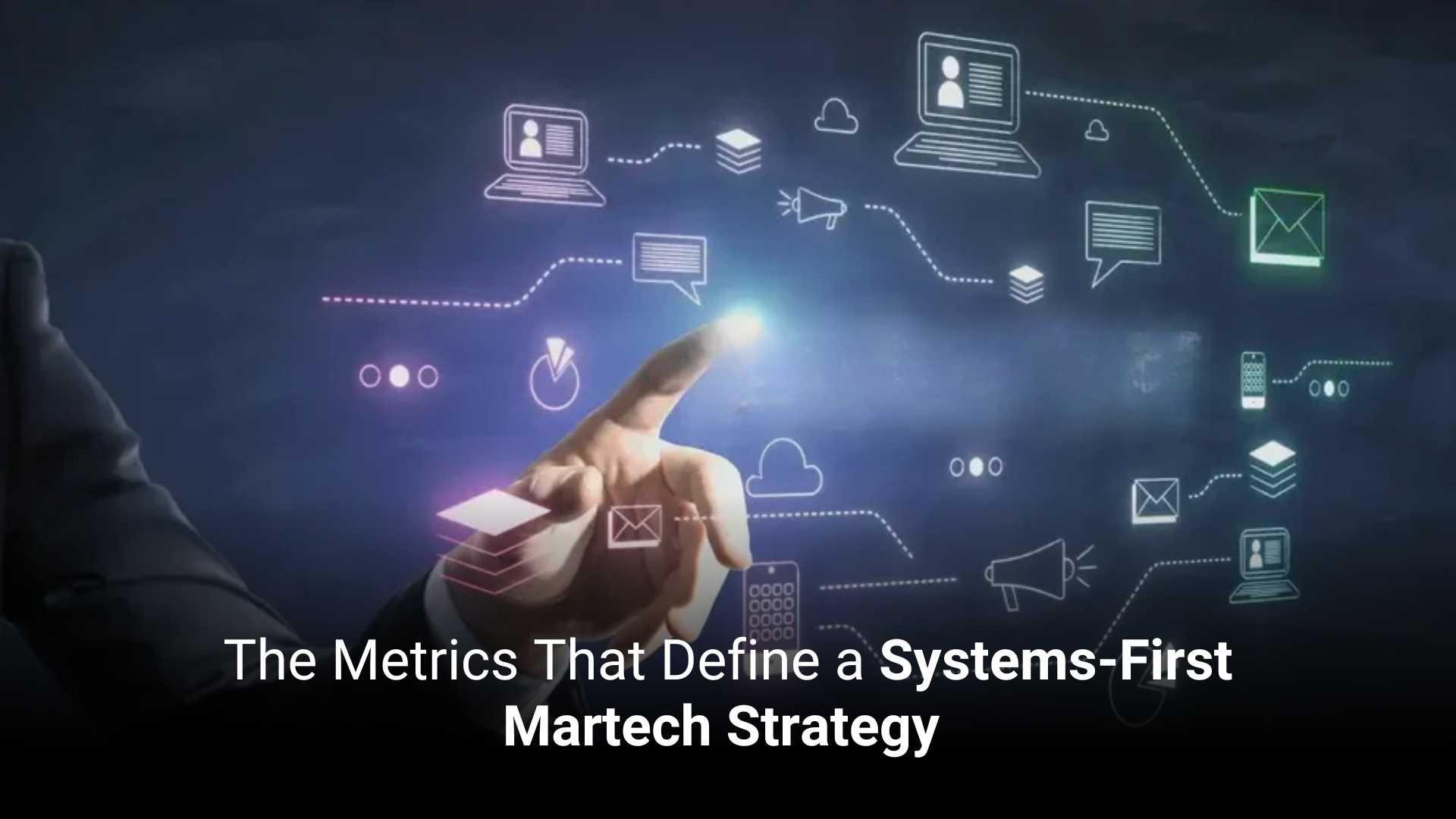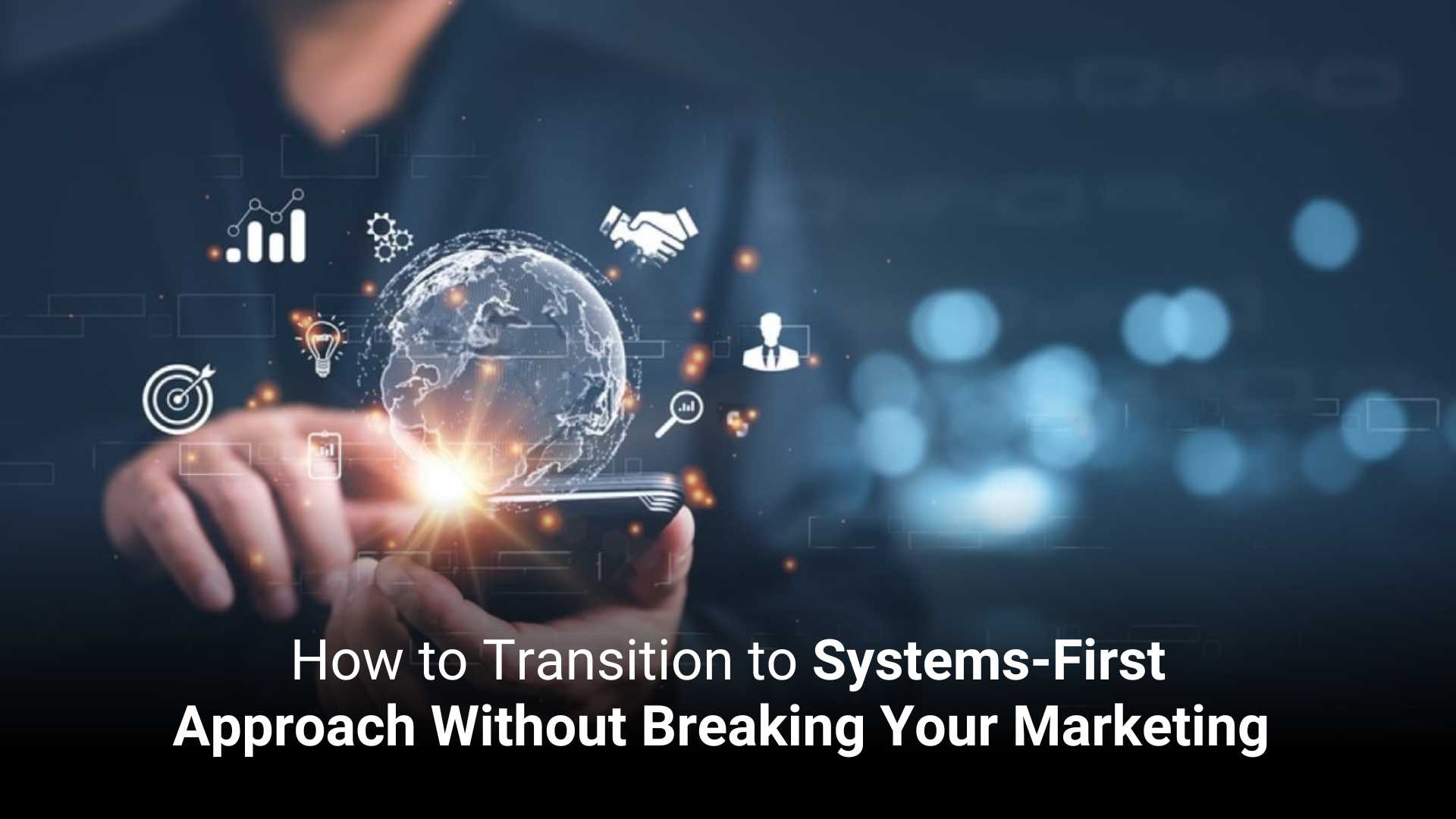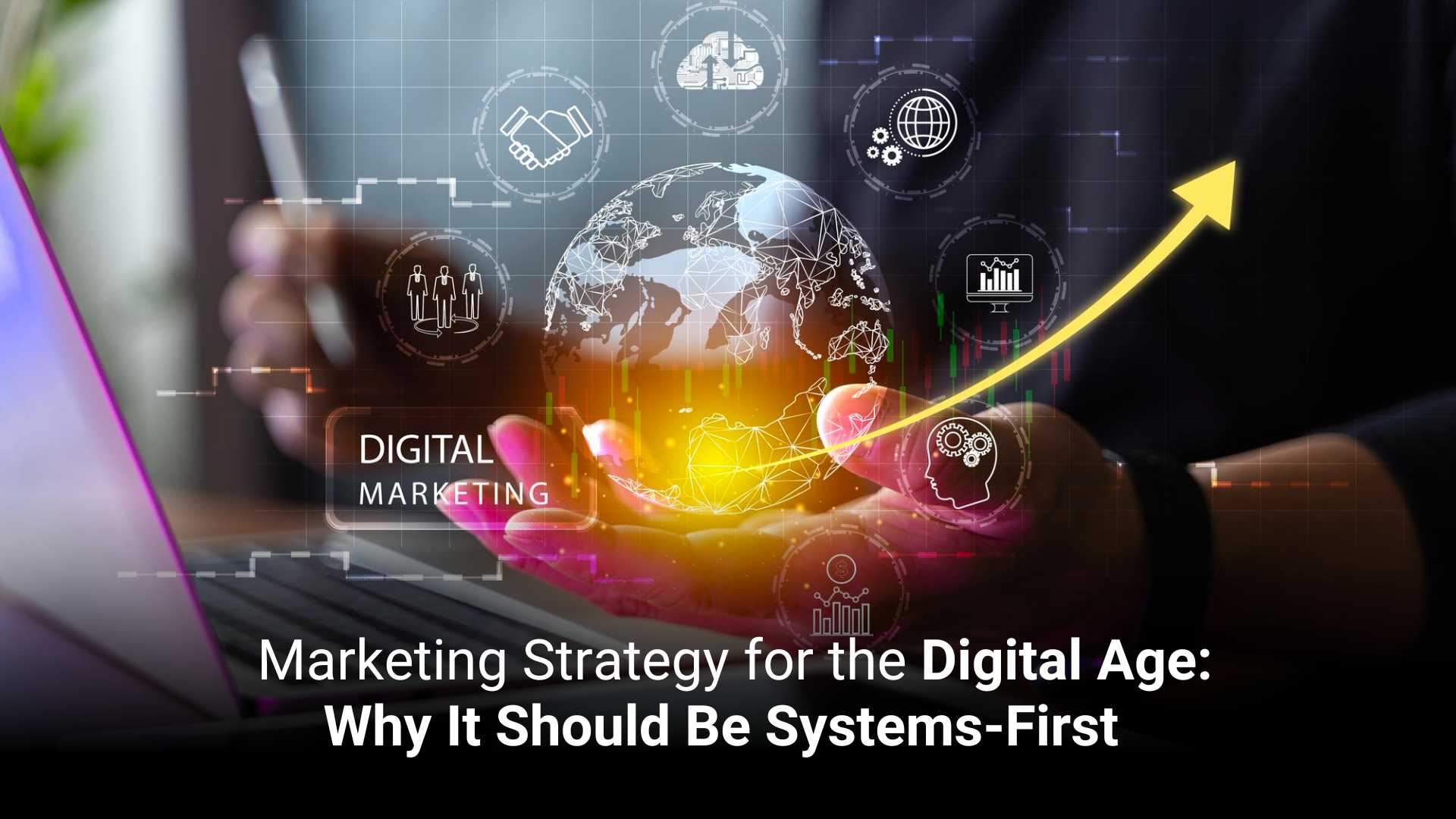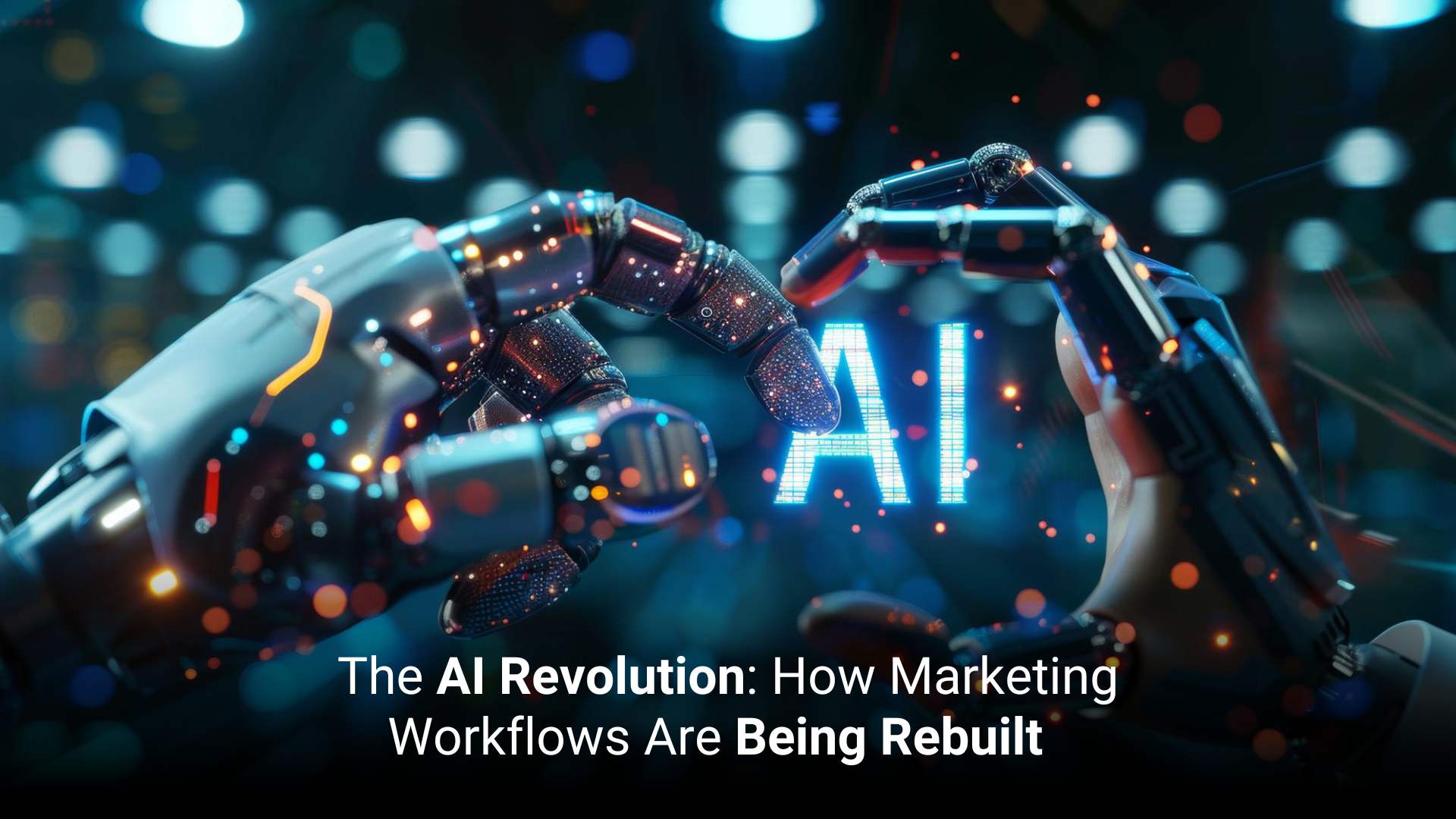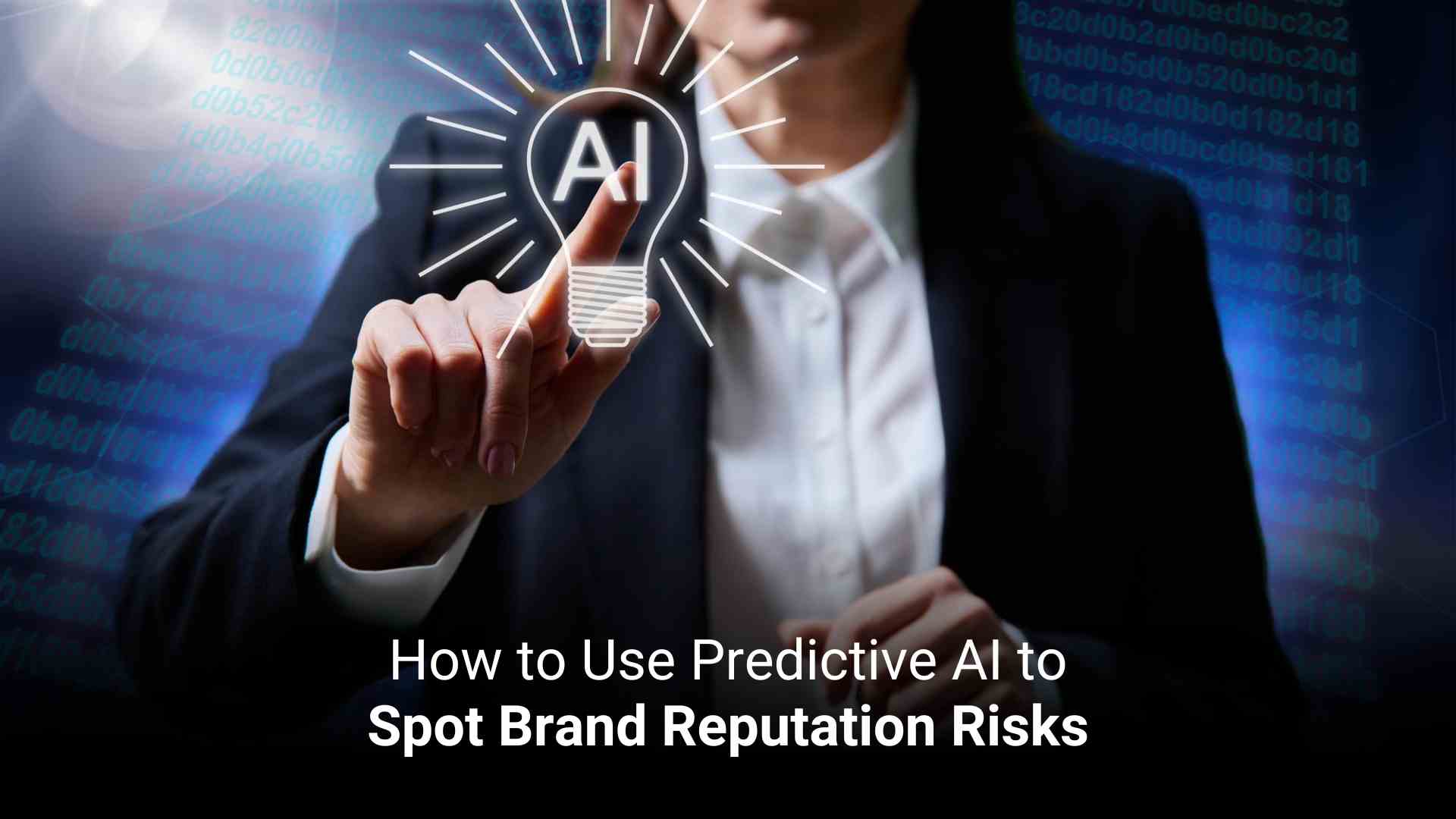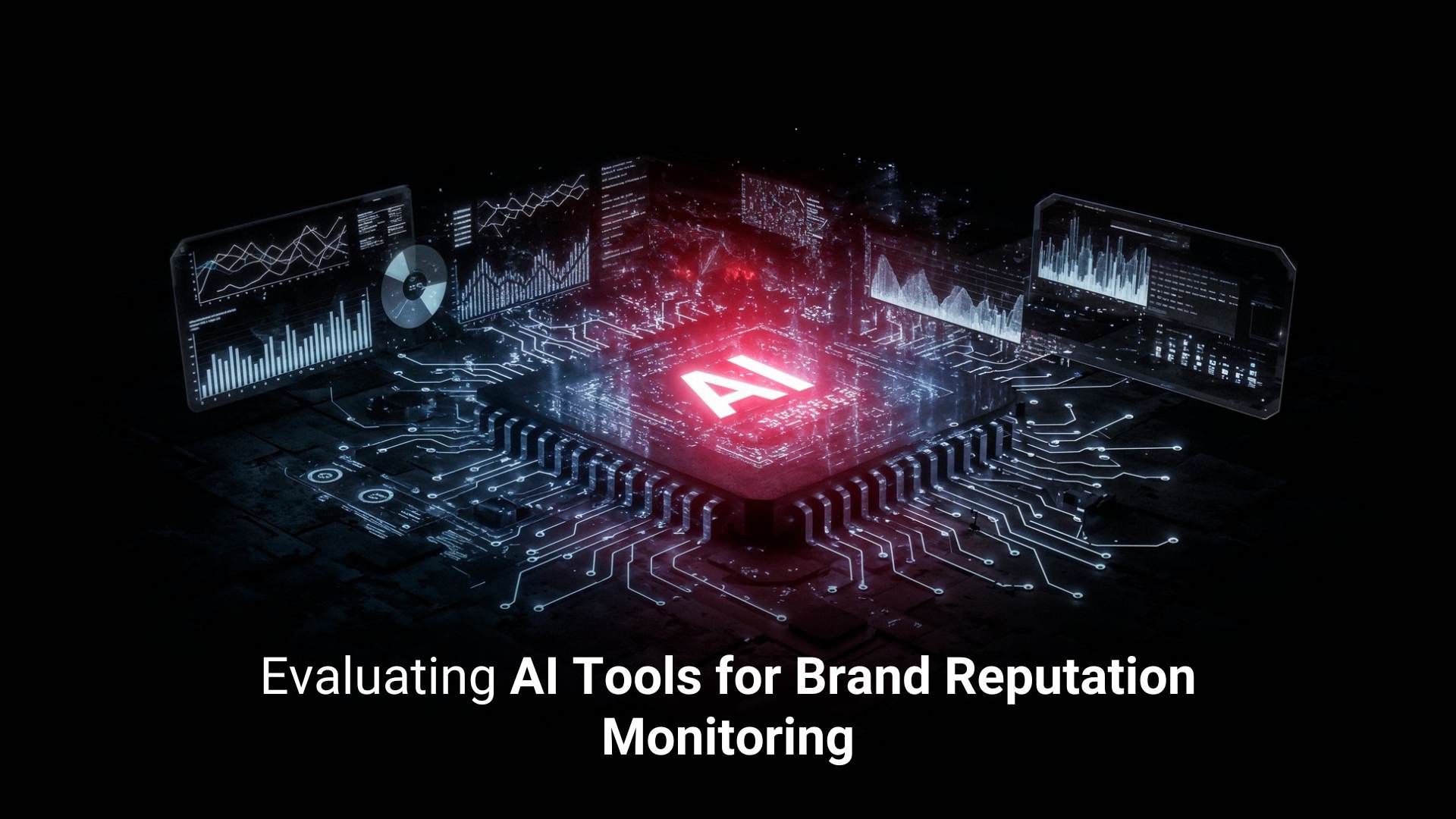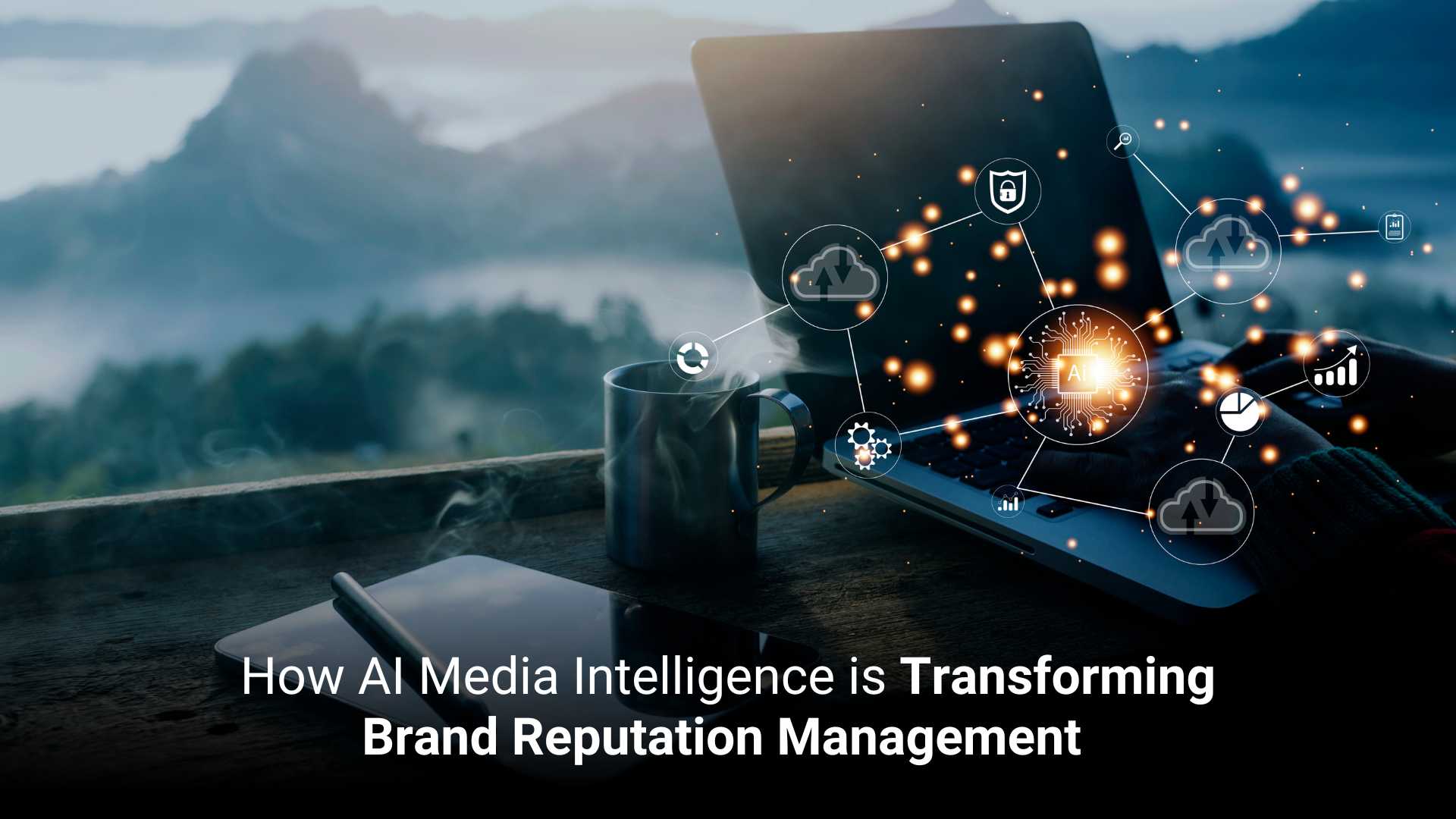
Featured Articles
The Metrics That Define a Systems-First Martech Strategy
marketing2 Sep 2025
Your marketing team invests in an automation platform. Campaigns launch faster, leads flow into the funnel, and analytics look promising. But a few months in, the picture begins to change. The sales team complains of inconsistent lead quality, and customer retention is not happening. What went wrong? The problem is the absence of a systems-first marketing approach that connects every team into one engine.
However, embracing systems-first marketing is also about measurement. It requires focus on KPIs that validate the business value. Without clear metrics, it is challenging to track clicks or impressions and understand their impact on revenue, customer lifetime value, or operational efficiency.
This article will discuss the metrics that define systems-first marketing.
Why Metrics Matter in a Systems-First Approach
Here's why metrics are important for a systems-first approach.
1. Metrics Provide Proof of Business Impact
Metrics ensure that your MarTech strategy demonstrates how campaigns directly contribute to revenue, pipeline growth, and customer lifetime value.
Example: A SaaS firm adopted systems-first metrics by linking campaign touchpoints to closed-won deals. It justified budget allocation and revenue contribution.
2. Metrics Align Marketing with Business Goals
Systems-first marketing connects outcomes to broader business goals such as sales velocity and retention. Metrics provide the alignment that marketing is driving measurable impact across the organization.
Example: A cybersecurity company integrated metrics with CRM and ERP data to enhance operational efficiency. By aligning KPIs to pipeline velocity and ARR growth, they were able to justify marketing investments.
3. Metrics Expose Gaps in Data Flow and Integration
Metrics reveal where bottlenecks exist. Without measuring these, you cannot identify integration failures that can harm customer experience.
Example: A manufacturer discovered that 20% of leads were being lost due to misalignment between their CRM and automation tools. Tracking metrics allowed them to fix the pipeline.
4. Metrics Strengthen Customer-Centric Decision Making
Metrics enable leaders to assess the effectiveness of engagement, personalization, and retention strategies across various touchpoints.
Example: A logistics provider used engagement and retention metrics to identify that webinar-driven leads had the highest retention rates.
Core Metrics That Define a Systems-First Martech Strategy
Below are the core metrics you should monitor to ensure your strategy delivers value.
1. Funnel Velocity and Conversion Ratios
What to Measure: Time taken for leads to progress from awareness to opportunity to closed, as well as stage-to-stage conversion percentages.
Why It Matters: The metrics will tell how quickly qualified leads move through the pipeline. Measuring funnel velocity highlights friction points.
Example: A cloud infrastructure provider tracked conversion ratios across campaigns. They identified that webinars produced a faster pipeline acceleration than whitepapers, leading to a realignment of the budget.
2. Campaign Deployment Metrics
What to Measure: Average time to launch a campaign and percentage of campaigns fully automated.
Why It Matters: Systems-first marketing emphasizes speed and scalability through automation and integrated workflows.
Example: A professional services firm reduced campaign launch cycles by measuring time-to-launch and identifying where automation could replace manual tasks.
3. Marketing-Sourced and Influenced Pipeline Contribution
What to Measure: Percentage of pipeline sourced directly by marketing; influenced pipeline from multi-touch campaigns.
Why It Matters: Leaders need to understand how much pipeline and revenue are generated from marketing efforts.
Example: A cybersecurity company demonstrated that multi-channel ABM campaigns influenced 40% of closed deals. These metrics secured more marketing budgets.
4. Customer Lifetime Value (CLV) and Retention Metrics
What to Measure: Average CLV per segment; churn rate; renewal rate; expansion revenue.
Why It Matters: Systems-first marketing ensures that the technology ecosystem supports retention, upselling, and long-term customer value.
Example: A SaaS provider tracked CLV across customer data and discovered accounts engaged through personalized onboarding campaigns had higher lifetime value.
5. Attribution and Multi-Touch Engagement Metrics
What to Measure: Attribution models (first-touch, last-touch, multi-touch); engagement rates across integrated channels.
Why It Matters: A systems-first approach ensures that attribution models are consistent, accurate, and relevant to the buyer's journey.
Example: A logistics technology firm transitioned from last-touch attribution to multi-touch modeling and discovered that LinkedIn campaigns had previously influenced deals that were previously credited only to email.
6. Return on Investment (ROI)
What to Measure: ROI for Tech Stack; cost per lead by system; technology utilization rates.
Why It Matters: Leaders need clear visibility into whether the MarTech stack is producing a return.
Example: An industrial manufacturing company discovered underused platforms consuming 18% of their MarTech budget. By consolidating tools and tracking ROI, they cut costs.
How to Build a Measurement Culture in Systems-First MarTech Strategy
Below are the practices leaders should adopt to embed measurement into everyday marketing operations.
1. Make Metrics a Leadership Priority
When executives request KPIs tied to business outcomes, teams learn to connect campaigns with revenue, retention, and operational efficiency.
Example: A FinTech enterprise restructured its quarterly business reviews to focus on pipeline contribution and customer lifetime value.
2. Establish Shared Dashboards Across Teams
Shared dashboards ensure marketing, sales, and operations all work from the same performance lens.
Example: A logistics provider created a cross-departmental dashboard linking CRM and marketing automation data. It improved pipeline accountability.
3. Integrate KPIs Into Daily Decision-Making
Metrics should guide real-time decisions. Leaders must encourage teams to use data in planning, budgeting, and campaign optimization.
Example: An IT services firm embedded KPI reviews into weekly meetings. Teams shifted budgets when engagement metrics revealed underperforming channels.
4. Balance Short-Term Wins with Long-Term Value
A healthy measurement culture avoids chasing quick wins at the expense of sustainable growth.
Example: A SaaS provider combined metrics on trial conversions with renewal rates to optimize their business strategy. It revealed that campaigns driving high sign-up volumes were not sustaining long-term retention, prompting a shift in strategy.
Conclusion
Without measurement, even the most effective MarTech stack risks becoming disconnected from its goals. With the right metrics, marketing becomes accountable for the business outcomes. Audit your current KPIs, identify gaps in alignment with business goals, and build a measurement framework. You will not only outperform competitors; your marketing will become a driver of growth.
How to Transition to Systems-First Approach Without Breaking Your Marketing
marketing25 Aug 2025
Your marketing team is in the middle of a major campaign. Suddenly, the reporting dashboard crashes, workflows fail, and data syncing across platforms is not happening. The team scrambles, but leads are missed, and campaigns lose Momentum. Many businesses face this issue when their marketing engine is built on scattered tools instead of a scalable system.
Transitioning to systems-first marketing doesn't mean hitting pause on your campaigns. You need to embed marketing automation into daily workflows such as lead scoring, nurturing, campaign tracking, and reporting. It saves time, and all your team's activity is aligned and measurable.
This article will explore how to transition into a systems-first framework without disrupting marketing.
What is Systems-First Marketing?
Systems-first marketing prioritizes structure and process before scaling campaigns or adding new tools. Instead of facing every marketing challenge, this approach builds a strong backbone that can support scalable growth.
One of the biggest enablers of systems-first marketing is marketing process automation. Tasks such as lead capture, nurturing sequences, campaign reporting, and pipeline tracking reduce human error and gain visibility into performance.
Systems-first marketing prevents bottlenecks and reduces dependency. It makes performance grounded in sustainable processes. Most importantly, it creates a foundation where innovation runs seamlessly in the background.
The Imperative Behind Going Systems-First Marketing
Here's why you need to go systems-first marketing.
1. Scalability Without Chaos
Marketing campaigns expand faster than the infrastructure. Without strong systems in place, growth leads to errors and inefficiency.
Example: A SaaS company scaling its Demand Gen discovered that manual lead routing caused delays. By adopting systems-first marketing, leads were routed, improving response time.
2. Consistency Across Channels
Buyers interact with brands across multiple touchpoints. Without a unified system, messaging and tracking are inconsistent.
Example: An IT services provider implemented centralized automation workflows for nurturing prospects across geographies, resulting in consistent communication.
3. Operational Efficiency and Cost Reduction
Manual processes consume valuable human resources. By shifting to systems-first marketing, organizations can lower operating costs.
Example: A consulting firm automated tasks like follow-up emails and reporting. This cut down manual work and allowed them to focus on strategy.
4. Future-Proofing the Marketing
A systems-first foundation makes it easier to adopt new tools without breaking existing workflows.
Example: When a cybersecurity company adopted an AI-powered personalization tool, the systems-first approach ensured standardized data flows.
How to Transition Without Breaking Marketing Momentum
Below are the key strategies for transitioning to a systems-first approach.
1. Audit Before You Automate
Start by mapping your current marketing workflows. Identify repetitive tasks, bottlenecks, and areas of manual intervention.
Example: A logistics company audited its lead nurturing workflows and discovered that follow-ups are manual. By automating these processes, they freed up sales without pausing campaigns.
2. Prioritize High-Impact Processes First
Identify the processes that deliver the most impact when automated. This staged rollout reduces disruption while quickly showing value.
Example: A SaaS provider automated lead scoring, ensuring sales never missed hot leads while larger integration projects were still underway.
3. Run Systems in Parallel Before Switching
Before shutting down entirely, run your new systems alongside current processes to validate accuracy and reliability, thereby minimizing risk.
Example: A consulting firm tested its new campaign reporting automation while still maintaining manual reports.
4. Communicate Change Across Teams
Clear communication ensures buy-in and alignment. Regular updates keep teams informed about what's changing and why it benefits them.
Example: An IT services company held monthly leadership briefings to showcase how automation was improving campaign visibility.
5. Leverage Quick Wins to Build Momentum
Highlight early wins to build credibility. Whether it's faster lead response times or improved reporting accuracy, these wins keep confidence in the investment.
Example: A software company reduced campaign setup time after automating asset approval workflows. It helped to secure additional budget for full automation.
6. Measure and Optimize
Systems-first marketing is an ongoing evolution. Track KPIs such as campaign velocity, lead conversion, and cost per acquisition to evaluate impact.
Example: A manufacturing firm monitored lead-to-opportunity conversion rates after automation and discovered an improvement.
Metrics to Track in Systems-First Marketing
The following are the metrics to track in systems-first marketing.
1. Lead Response Time
Measures how quickly sales engage with new leads once they enter the system. It ensures leads are scored, prioritized, and routed.
Example: A SaaS provider reduced response time using automated lead routing, resulting in a lift in conversion rates.
2. Marketing Sourced vs. Influenced Pipeline
Tracks how much pipeline is directly generated by marketing activities. Integrated systems enable leadership to see the impact.
Example: A cybersecurity company used automated attribution models to show that marketing influenced the majority of deals.
3. Campaign Velocity
Evaluates how fast campaigns move from planning to execution. The automation eliminates delays in approvals and reporting.
Example: A consulting firm cut campaign launch time after automating creative approval workflows.
4. Cost per Acquisition (CPA)
Tracks the efficiency of customer acquisition efforts. It reduces manual overhead and operational waste, lowering acquisition costs.
Example: A manufacturing company streamlined email nurturing sequences and reduced CPA within the first quarter.
5. Conversion Rate by Stage
Tracks how prospects move from lead to opportunity to closed deal. No lead is left unattended, increasing conversion consistency.
Example: A logistics solutions provider improved MQL-to-SQL conversion after automating follow-up sequences.
Conclusion
Transitioning to a systems-first marketing approach helps you build a strong, scalable foundation. The real advantage lies in balance: executing today's campaigns while laying down the infrastructure for tomorrow's growth. With a systems-first mindset, your leads will not fall through the cracks or operational bottlenecks. Start with small wins, scale your foundation gradually, and ensure every process strengthens your marketing momentum.
Ready to future-proof your marketing? Start with us!
Marketing Strategy for the Digital Age: Why It Should Be Systems-First
marketing18 Aug 2025
Your marketing team is running multiple campaigns across channels. Each channel is performing, but when you try to connect the dots, you hit a wall. Data sits in silos, campaign insights are fragmented, and optimization slips. You’re moving fast, but without a connected system, you’re flying blind.
But why the shift? Customers move between devices, platforms, and touchpoints. A fragmented strategy might capture their attention, but without a connected system, you can’t adapt. A systems-first approach allows you to see the entire customer journey, understand behavior patterns, and respond with the right message.
This article explains why your marketing strategy should be systems-first.
What Does “Systems-First” Marketing Mean?
Systems-first” marketing means designing your marketing strategy around a unified process for creative outputs. It’s a shift from chasing one-off tactics to building the Integrated marketing systems that make those tactics work together with measurable impact.
Instead of launching isolated campaigns on LinkedIn, email, and industry events, a technology firm builds an integrated marketing system where each channel feeds data into a shared dashboard. Marketing and sales can see which accounts are engaging, what content resonates, and where prospects are in the buying journey.
Why the Digital Age Demands a Systems-First Strategy
The digital age demands a systems-first strategy. Here’s why.
1. Buyer Journeys Require Connected Insights
B2B buyers interact with multiple touchpoints before engaging sales. With a systems-first approach, a manufacturing solutions provider could integrate website analytics, content downloads, and trade show interactions into a single dashboard.
2. Speed and Agility Are Competitive Advantages
Whether it’s a competitor launching a new product or evolving customer needs, integrated marketing systems enable pivots by centralizing data and automating workflows. For instance, a cybersecurity firm could detect spikes in engagement from a specific industry segment and launch a targeted content sequence.
3. Proving ROI Demands End-to-End Tracking
C-suite leaders want evidence that marketing drives growth. Systems-first approach links campaign spends, lead quality, and closed-won deals, giving them a shared view of ROI. For example, a logistics solutions company can track how a specific LinkedIn ad directly influenced a contract.
4. Operational Efficiency Frees Up Strategic Bandwidth
By automating repetitive tasks such as lead nurturing, reporting, and campaign tagging, leaders can redirect their focus to strategic initiatives.
How to Implement a Systems-First Approach
Here is the process to implement the systems-first approach.
1. Start with a Unified Vision Across Leadership
A systems-first approach is when marketing, sales, and operations agree on shared business objectives. For example, in a SaaS company, aligning the CMO, CRO, and COO on revenue targets ensures that the marketing system is built not only for lead generation but also for pipeline acceleration and customer retention.
2. Audit Your Current Tech Stack
Evaluate existing platforms for overlap or underutilized features. A manufacturing solutions provider finds that their CRM has advanced reporting capabilities, but they’re paying separately for analytics software that delivers redundant insights.
3. Integrate for a Single Source of Truth
The approach connects CRM, marketing automation, analytics, and customer success platforms. It enables real-time tracking from first touch to renewal. For instance, a logistics technology company connects Salesforce, HubSpot, and Power BI to track how webinar attendees progress through the sales funnel.
4. Leverage Data for Predictive Insights
Systems-first strategies thrive on data not just for reporting, but for forecasting. A healthcare solutions provider uses data to predict which accounts are most likely to churn, enabling proactive retention campaigns.
5. Enable Cross-Functional Access and Transparency
Your strategy should empower all stakeholders with visibility into the same dashboards and KPIs. An industrial equipment supplier creates an executive dashboard that shows marketing ROI, lead conversion rates, and customer acquisition costs.
6. Iterate and Optimize
Continuously refine integrations, workflows, and reporting structures based on evolving business goals. For example, a cloud infrastructure provider expands their integrated system to include ABM once it shifts to targeting enterprise-level accounts.
How Implementing a Systems-First Approach Benefits
Here’s how a systems-first approach helps your business.
1. Improved ROI Visibility
Integrated marketing systems allow you to connect campaign spend directly to business outcomes. A logistics solutions company, for instance, can identify that a targeted LinkedIn ad campaign generated $2M in new contracts by tracking the lead through every stage of the sales funnel.
2. Enhanced Customer Experience
A systems-first approach ensures engagement from first contact to ongoing service. For example, an IT services provider could trigger a tailored onboarding email sequence after a client signs a contract, while also alerting the account manager to schedule a personalized welcome call.
3. Faster Market Responsiveness
With integrated marketing systems, organizations can respond in days to competitive activity. For instance, a cybersecurity solutions firm noticing a spike in demand for ransomware protection can quickly deploy targeted ads, update sales enablement content, and launch a webinar campaign.
4. Scalability Without Losing Control
As businesses grow, so do campaigns, channels, and customer segments. With Integrated marketing systems, scaling becomes easy. A healthcare solutions provider could expand into new regions while maintaining consistent messaging, centralized reporting, and unified customer data.
5. Operational Efficiency and Cost Savings
A systems-first model automates tasks such as lead scoring, campaign reporting, and follow-up sequences. For example, an industrial manufacturing company could automate re-engagement campaigns for dormant leads, recovering potential pipeline opportunities.
6. Better Collaboration Across Teams
When marketing, sales, and customer success all work from the same system, collaboration improves. An enterprise software company uses a shared dashboard that displays campaign performance, pipeline health, and customer satisfaction scores.
7. Data-Driven Innovation
A systems-first approach fuels innovation. A cloud infrastructure company with an integrated marketing system identifies usage patterns that suggest a need for a new service, enabling marketing to craft a targeted launch campaign.
Conclusion
A systems-first approach is a shift from “more activity” to “better-connected activity,” where every touchpoint is part of the data-driven growth engine. The sooner you build the foundation, the sooner you will see benefits in efficiency, agility, and revenue performance.
A leader can connect every marketing effort directly to revenue impact, adapt to market shifts, and deliver experiences at scale. A systems-first approach makes it possible and sustainable.
How Martech Leaders Can Partner with Event Marketing
events12 Aug 2025
You're attending an industry conference. As you walk through, you notice how attendees are interacting with AR product demos and connecting with brands through event apps. By the time the keynote address happens, data points have already been captured for session check-ins to social media engagement.
Today's events are powered by Event Tech, which is integrating digital tools with experiences to create measurable interactions. For Martech, this shift aligns event marketing strategies with data-driven goals and execution. Whether it's a virtual summit, an in-person conference, or a hybrid experience, events offer an environment for brands to engage their target audiences. People remember experiences, and events generate first-party data such as attendee behavior and content preferences, which adds to the marketing value.
This article talks about the significance of event marketing for MarTech.
Why Event Marketing Matters in the Digital Age
1. First-Party Data Collection Through Event Tech
Events are a goldmine for zero- and first-party data. Modern event tech platforms track registration, session participation, and interactions, which can become data.
Example: A SaaS enterprise used event tech to track attendee engagement across its annual user conference, enriching CRM profiles.
2. Events Accelerate the Sales Cycle
Bringing decision-makers into an event fast-tracks relationship-building and purchase intent. Unlike cold emails, events offer real-time conversations and feedback.
Example: A Fintech firm saw a shorter deal cycle after hosting a private C-suite roundtable, which synced insights directly into their sales pipeline.
3. Thought Leadership
Hosting or speaking at industry events elevates brand visibility and credibility. Events also position executives as industry experts.
Example: A company used a branded virtual summit to showcase customer success stories and thought leadership, generating qualified leads.
4. Events Fuel Content and Campaigns
Each event becomes a content engine, encompassing session recordings, Q&As, post-event blogs, and email campaigns.
Example: An analytics provider repurposed content from its analyst panel webinar into a lead magnet, newsletter series, and podcast.
5. Measurable ROI with Smart Event Tech
Event tech now enables dashboards tracking attendee behavior, lead conversion, and session feedback aligned directly with marketing KPIs.
Example: A global enterprise used event tech analytics to influence the pipeline to its annual leadership forum.
What Role Does Event Tech Play in B2B Events
1. Seamless Integration with Martech Stack
Event tech integrates directly with CRMs, MAPs, and analytics tools, making it easy to sync attendee data, score leads, and track pipeline impact.
Example: A cybersecurity firm integrated its event platform with HubSpot, enabling data capture during its annual summit and automating targeted post-event email sequences.
2. Real-Time Engagement and Interaction Tools
Live polls, Q&As, chat features, and networking platforms drive active participation in virtual or hybrid events.
Example: A FinTech company used live polling and interactive Q&A during a virtual investor event, capturing insights that were later used in their marketing campaign.
3. Actionable Analytics and ROI Measurement
Event Tech platforms now offer detailed dashboards that track session popularity, engagement scores, lead quality, and pipeline attribution.
Example: A global brand used event analytics to identify the top-performing sessions at their product launch, then used that content to inform their sales playbooks.
4. Scalability for Global Reach
With hybrid and virtual capabilities, event tech enables brands to host global audiences without physical limitations.
Example: A SaaS company expanded its annual partner event from 300 in-person attendees to over 2,000 global participants using a hybrid model.
5. Post-Event Nurturing and Content Repurposing
On-demand content hosting, automated follow-ups, and content segmentation ensure the event's value lives beyond the live date.
Example: An analytics platform used event tech to create a gated content hub post-event, generating new leads in the weeks that followed.
Why Martech Integration Is Critical for Event Success
1. Unified Customer Data for Personalization
When event tech integrates with your CRM or CDP, attendee data becomes data. You can recommend sessions and send targeted messages based on previous interactions.
Example: A software firm synced its event platform with Salesforce, enabling tailored email campaigns pre- and post-event.
2. Real-Time Lead Scoring and Routing
Martech integration enables lead scoring based on session attendance, booth visits, and engagement levels, allowing sales teams to follow up.
Example: A cybersecurity vendor used integrated event tech to trigger real-time alerts for hot leads, leading to faster SDR follow-up.
3. Closed-Loop Reporting for ROI Tracking
Integrated systems help track event influence across the funnel from registrations, MQLs, SQLs, and event revenue.
Example: A data platform attributed $1.2M in pipeline to a single event by integrating event analytics into their marketing dashboard.
4. Content and Campaign Continuity
Post-event content, such as session recordings, poll results, or Q&A highlights, can be pushed into nurture streams and retargeting campaigns.
Example: A fintech enterprise repurposed webinar clips from an event into a multichannel ABM campaign, driving higher engagement.
How Martech Leaders Can Enhance Event Marketing
1. Leverage Data for Audience Segmentation and Targeting
Use CRM and marketing automation data to invite the right attendees, segment them by industry, role, or behavior.
Example: A cloud infrastructure firm used customer data to create personalized event tracks for CIOs, developers, and procurement leaders.
2. Optimize Pre-Event Engagement
Use event tech to warm up audiences with personalized emails, content previews, and polls.
Example: A SaaS analytics company created a content drip campaign before a virtual forum.
2. Enable Real-Time Personalization During Events
Integrate event tech with Martech tools to personalize in-platform experiences based on attendee profiles.
Example: A marketing automation platform used attendee data to facilitate 1:1 meeting, improving event satisfaction scores.
3. Extend Post-Event Impact with Nurture Programs
Feed attendee behavior into nurturing workflows such as retargeting campaigns, sales outreach, or content recommendations.
Example: A FinTech brand created personalized recap emails with content links, increasing post-event engagement.
4. Drive Continuous Improvement with Data Insights
Analyze event performance across touchpoints, including registrations, engagement, and leads generated, to inform future strategy.
Example: A global enterprise used event analytics to refine session topics and keynote speakers, increasing NPS.
Conclusion
Event marketing doesn't just enhance attendee experience; it arms marketing and sales with the intelligence to convert and build long-term customer relationships. The partnership between Martech and event marketing builds synergy, which gives a distinct edge.
Why Martech Needs Multi-Disciplinary Content Strategies
marketing5 Aug 2025
Your team rolls out a new Martech platform packed with data and analytics. It segments the audience, pushes content across channels, and tracks engagement. However, leads don't convert, and sales teams complain that the content feels "out of touch." So, what went wrong?
Content strategies are mainly driven by marketing, with limited inputs from sales, product, data, or customer success. But today's Martech stack is multi-functional; it touches every stage of the customer journey and relies on buying signals and behavioral data. Instead of planning by campaign, they must plan by journey stage and user behavior. They need agile, test-and-learn models that respond to insights in real time.
This article will discuss why MarTech requires multi-disciplinary content strategies.
Why Siloed Content Strategies Are Failing in Martech
Here's why you need to change your content strategy.
1. Fragmented Customer Experience
When content is created in silos, it leads to inconsistent messaging across touchpoints. A potential buyer might encounter thought leadership content that speaks one language, sales collateral that says another.
Example: A SaaS firm's content marketing team publishes blog posts focused on innovation, but the sales deck still revolves around outdated features.
2. Martech Needs Data-Driven Personalization
Martech platforms are built to deliver personalized experiences based on behavior, intent, and funnel stage. However, if content teams fail to collaborate with teams, the content will remain generic.
A marketing automation tool can send personalized nurture emails, but if the content team doesn't use it, the emails will use generic copy.
3. Wasted Resources and Duplicated Efforts
Siloed teams often create overlapping content without visibility into each other's work, wasting time and budget.
Example: A cybersecurity company sees both product marketing and customer success teams developing similar case studies, unaware of each other.
4. Missed Revenue Opportunities
Critical content gaps go unnoticed, especially at the bottom-of-funnel and post-sale stages. It impacts pipeline velocity and customer retention.
Example: A Martech vendor attracts TOFU leads through content but fails to provide product-specific ROI calculators or assets that would help sales.
5. Slower GTM Execution
Siloed content creation leads to delays in campaign execution and slow market signals.
Example: A competitor launches a feature update. While the product team is ready to respond, the content team is behind in creating supporting assets.
How Organizations Foster Cross-Team Collaboration for Content Strategy
Successful execution hinges on how well Marketing, Sales, Product, IT, and Data teams collaborate.
1. Establish a Content Governance Framework
Create a shared structure that outlines roles, responsibilities, and review protocols across departments. It ensures every piece of content aligns with business goals.
Example: A cloud infrastructure provider implements a content council that includes leaders from various teams.
2. Align on Customer Journey Mapping
Cross-functional teams should co-create a customer journey to understand pain points, needs, and moments of decision.
Example: A Martech vendor's product team highlights feature adoption challenges during onboarding. Marketing then tailors email content and in-app guides to address those hurdles.
3. Use Martech Platforms as Collaboration Hubs
Leverage Martech tools for cross-team collaboration. Integrate CRM and CMS to provide visibility across functions.
Example: A FinTech firm uses a shared content calendar that gives Sales and Product visibility into what content is being developed, when, and why.
4. Drive Content with Data
Data teams should provide insights into what content is converting, which assets are being ignored, and where drop-offs occur.
Example: The analytics team at a cybersecurity company shares heatmaps and engagement data on demo pages, helping marketing optimize messaging.
5. Incentivize Cross-Functional Outcomes
Performance KPIs should reflect collaborative success. Tie goals like content engagement, MQL quality, or sales cycle velocity.
Example: At a SaaS firm, both marketing and product teams are measured on feature adoption, encouraging them to co-create better.
What Does "Successful" Multi-Disciplinary Content Look Like in Practice?
A multi-disciplinary content strategy ensures that content speaks to the right audience through the right channel.
1. Unified Messaging Across the Funnel
Successful multi-disciplinary content maintains consistent messaging from awareness to post-sale, aligning brand voice with business outcomes.
Example: A SaaS company develops a "value narrative" with Marketing and Product, and applies it to blog posts, demo scripts, sales presentations, and onboarding materials.
2. Content That Reflects Customer Needs
Great content strategies are rooted in customer insights uncovered by Sales, Support, and Data teams.
Example: A Martech vendor uses insights from its sales team's objection handling and CRM data to create an FAQ-driven eBook that addresses common barriers to adoption.
3. Personalization Driven by Martech Tools
Successful content uses Martech platforms for behavioral personalization. This is only possible when Marketing, Data, and IT collaborate.
Example: An analytics platform sends tailored nurture emails based on industry and content consumption behavior, whereas industry blogs are used for early-stage prospects.
4. Cross-Team Campaign Execution
Multi-disciplinary content strategies shorten production timelines and increase agility by integrating content planning.
Example: A fintech firm launches an industry report supported by coordinated assets: marketing handles promotion, sales create pitch decks, product adds feature commentary, and data teams validate insights.
Benefits of a Multi-Disciplinary Content Strategy for Martech
Here's how this approach drives impact in organizations.
1. Agile Campaign Execution
Cross-functional teams work in pods or shared workflows to produce content faster and respond to market changes.
Example: A Martech firm launches a new product feature. Within days, product marketing delivers messaging, sales equip reps with decks, and demand gen pushes a multi-channel campaign.
2. Personalized Content at Scale
With Data and IT teams embedded in content planning, organizations create experiences based on industry or lifecycle stage.
Example: A cybersecurity company uses CRM data to trigger web content and email sequences tailored to a visitor's role and risk profile.
3. Higher Content ROI Through Performance Optimization
Data and analytics teams help content creators track their performance, enabling better budget allocation and marketing efficiency.
Example: An analytics SaaS company uses performance dashboards to track which whitepapers drive the pipeline.
4. Greater Internal Collaboration
Breaking down silos reduces misalignment, fostering a shared sense of ownership.
Example: A fintech provider's content calendar is accessible across marketing, sales, and product teams.
Conclusion
It is essential to break the silos, align your teams, and build a content strategy that mirrors your Martech stack. Start by creating a multi-disciplinary content team. Bring your key stakeholders to the table and let content become the connector between innovation and impact.
Ready to align your teams and amplify ROI? Build your content strategy today!
The Martech Toolkit for Creators: From AI Headshots to Streamlined Content Production
marketing29 Jul 2025
You're a creator juggling five platforms, three content formats, and a community. You're bouncing between Canva, Google Docs, and drafts while trying to maintain a personal brand and still somehow stay creative. The daily hustle for modern creators is exhausting, and now it can be changed.
The creator economy is a full-blown industry, and MarTech powers it. Martech tools are now becoming creator-friendly, intuitive, and AI-powered. From AI-generated headshots to scheduling tools that post your content, the Martech toolkit now caters to the workflows of creators.
In this article, we'll break down the essential Martech tools every creator should know.
The Evolved Martech Toolkit for Creators
The following is the MarTech toolkit, powered by AI.
1. Branding Basics: Tools for AI-Powered Visual Identity
A creator's visual identity is their first impression for clients. It's about brand recall, professionalism, and consistency across customer touchpoints.
AI Headshots & Profile Builders
Tools like Headshot Pro and Aragon use Gen AI to create professional profile photos without the cost or logistics of a photoshoot.
Example: A SaaS founder launching a LinkedIn thought leadership series used Headshot Pro to ensure consistent personal branding across investor decks, media kits, and podcast guest profiles.
Logo & Brand Kit Generators
Platforms like Canva Brand Hub and LogoAI empower creators to establish brand kits including logos, fonts, color palettes, and templates.
Example: A CRM consultant utilized Canva Brand Hub to create a brand identity for webinars, email templates, and LinkedIn carousels, serving as a client pitch and content touchpoint.
Advantage: Investing in visual identity tools helps creators look enterprise-ready, even as a team of one.
2. Content Ideation & Planning:
Ideation fatigue happens when creators are expected to produce daily content across formats. AI tools can turn mental blocks into structured ideas.
AI Idea Generators Tools
Platforms like ChatGPT and Jasper assist creators in brainstorming content angles, script hooks, and email subject lines.
Example: A marketing agency utilized ChatGPT to create a 30-day content calendar spanning four client verticals.
Editorial Calendars & Planning Tools
Tools like Notion and Airtable, combined with AI plugins, enable creators to build content calendars, track stages of production, and set task reminders.
Example: A HRTech company used Airtable's AI to score content ideas based on audience engagement metrics from past posts.
Advantage: With AI-enhanced MarTech, content operations become measurable and scalable.
3. Creation Tools: From Text to Video
Creating a core content lifecycle can utilize AI to streamline multi-day processes into single-click workflows.
Copywriting & Caption Tools
Tools like Copy.ai and Writesonic help create ad copy and email subject lines.
Example: A fintech content team utilized Writesonic to generate LinkedIn captions based on whitepaper summaries, thereby reducing their content adaptation time.
Video & Audio Production Tools
AI tools like Descript and Runway ML allow creators to edit videos as easily as text documents, and clean up audio with minimal technical background.
Example: A CFO turned LinkedIn creator used Descript to turn Zoom webinars into short-form videos, saving on agency fees and scaling video content in-house.
Design & Repurposing Tools
Tools such as Canva and Adobe Express enable creators to transform one asset into multiple formats for each channel.
Example: A MarTech platform repurposed one infographic into blog headers, Instagram posts, LinkedIn carousels, and webinar slide decks using Canva's AI.
Advantage: AI-driven content creation tools reduces cost centers while increasing production velocity.
4. Publishing & Distribution
A polished piece of content is only valuable when it's seen. Martech tools now automate distribution across channels—saving creators from death-by-dashboard.
Scheduling Tools
Platforms like Buffer or Later enable creators to publish content across LinkedIn, Instagram, X, and newsletters.
Example: A solopreneur business coach grew followers in 6 months by scheduling weekly content drops with Buffer while running client sessions.
Multi-Platform Automation
Zapier integrates publishing across platforms and triggers notifications, CRM updates, or Slack alerts based on publishing activity.
Example: A SaaS founder set up a Zapier workflow that triggers LinkedIn announcements, email updates, and Slack pings to the sales team whenever new blog posts are published.
Advantage: Martech's distribution layer ensures that content doesn't just sit in drafts. It moves on time, in sync, and with strategic impact.
5. Analytics & Growth Tracking
Martech tools now allow creators to treat content like performance marketing—with real-time insights and iteration loops.
Content Performance Dashboards
Tools like Metricool and Hypefury Analytics provide insights into reach, engagement, CTR, and post timing across various platforms.
Example: A founder used Metricool to identify the optimal posting times for LinkedIn, increasing engagement without altering the content.
Audience Feedback & Iteration Tools
Platforms like Circle and Discord direct input loops to co-create with your audience.
Example: A cybersecurity influencer utilized Discord community polls to prioritize topics, then created weekly videos based on what the audience cared about most.
Advantage: With AI-powered analytics and audience tools, creators can test, learning, and refine their content.
Why It's Critical to Adopt the AI Martech Toolkit for Creators
Here's why adopting an AI-powered marketing technology (Martech) toolkit is beneficial.
1. Maintain Consistency Across Platforms
Creators engaging across LinkedIn, email, YouTube, and podcasts need messaging consistency. Martech tools help optimize the output through templates and scheduling automation.
Example: A HRTech company utilized Canva's Brand Hub to ensure that all content adhered to brand guidelines across webinars, carousels, and paid advertisements.
2. Reduce Production Bottlenecks
AI video editors, image generators, and automation tools compress production time.
Example: A consultant utilized Descript to transform lengthy Zoom calls into concise video clips for LinkedIn within 24 hours.
3. Drive Better Content Decisions with Data
Martech platforms provide performance analytics and audience insights that guide content strategy.
Example: A MarTech startup utilized Metricool to analyze their LinkedIn engagement and identified a lift in engagement when posting insights from founders versus brand pages.
4. Stay Competitive in the Market
Content velocity and relevance are crucial to maintaining visibility. Those using AI MarTech tools are moving faster and testing smarter.
Example: A cybersecurity influencer leveraged AI caption tools and scheduling platforms to post daily content across various platforms, thereby growing their audience.
Conclusion
The creator economy is moving toward higher output, faster cycles, and personalization. Those who adopt AI-enabled workflows carve out a more substantial brand presence. Start small by picking one AI tool and continuing from there. The right Martech toolkit is not just an upgrade; it's your competitive advantage.
Want to change your story in marketing? Talk to Us
AI Meets the Arts: Why Digital Creators Are Embracing Intelligent Tools
artificial intelligence21 Jul 2025
A digital artist is working on cityscape design. Instead of designing every building from scratch, they take the help of an AI. Within seconds, they’re presented with variations aligned with their unique needs. They tweak, combine, and refine to blend human intuition with machine precision. Intelligent tools are helping digital creators reshape the creative process.
So why are intelligent tools gaining traction? AI tools assist creators in generating drafts and exploring creative directions. Time saved on technical tasks can be reinvested into storytelling, concept development, or experimentation.
Secondly, certain creative outputs require expensive software or niche technical skills. Intelligent tools can help a creator without formal training produce studio-grade visuals, music, or copy.
This article will discuss how digital creators embrace intelligent tools.
Why Is AI Gaining Popularity in the Creative Industry?
Here’s why AI is becoming a must-have tool for creative teams.
1. Accelerates the Creative Process
AI tools help digital creators generate concepts, mood boards, and design options. With agencies under tight client deadlines, tools like Midjourney allow teams to ideate and visualize faster, without sacrificing creativity.
Example: A branding agency can utilize AI tools to generate logo variations based on a creative brief.
2. Enhances Content Personalization
AI enables the personalization of visuals, videos, and copy useful in B2B marketing. Tools like Jasper help marketing teams tailor content to different customer personas, industries, or regions.
Example: A SaaS company running a regional campaign can utilize AI to localize ad creatives and email copy, thereby boosting engagement.
3. Reduces Repetitive Design Tasks
Designers spend a significant amount of time resizing assets, refining visuals, and editing product photos. AI tools can do these tasks, freeing up creators to focus on strategy and innovation.
Example: A product design studio can use Adobe’s AI-powered tools to generate design layouts or remove backgrounds.
4. Makes Creative Tools More Accessible
AI platforms reduce the learning curve for non-designers. Small businesses and startups can now create high-quality visuals, videos, and brand assets without hiring a large creative team.
Example: A startup founder with no design background can use tools like Canva’s AI features to design pitch decks, social media posts, and branded graphics.
5. Unlocks New Creative Possibilities
AI can become a valuable collaborator by suggesting new ideas, blending content styles, or creating visual effects. AI helps push creative boundaries.
Example: A digital agency experimenting with generative art can use AI to produce surreal visuals for a marketing campaign.
AI Technologies Being Used by Digital Creators
Here are some of the AI technologies being adopted by digital creators.
1. Generative AI for Visual Content
Tools like DALL·E and Adobe Firefly enable creators to generate high-quality images, illustrations, and design concepts from simple text prompts.
Example: A marketing agency uses Midjourney to create visual storyboards for client pitches, offering creative options.
2. AI-Powered Video Editing
Platforms like Pictory enable digital creators to edit videos with ease, auto-generating subtitles, removing filler words, and even replacing visuals using AI.
Example: A content production firm utilizes RunwayML to transform long-form client webinars into concise video clips for LinkedIn, complete with captions and branded elements.
3. AI Copywriting Tools
Writing assistants like Jasper and Copy.ai help content creators craft headlines, blog posts, emails, and product descriptions with personalization.
Example: A SaaS company’s in-house marketing team uses Jasper to generate variations of product messaging for A/B testing across different customer segments.
4. AI Design and Layout Tools
AI embedded in platforms like Canva, Figma, and Adobe Express can generate layouts, adjust color schemes, and suggest typography.
Example: A startup founder with limited design resources uses Canva’s AI tools to generate sales presentations.
5. Voice and Audio AI
AI tools like ElevenLabs and Lovo.ai offer voice synthesis for narration, voiceovers, and audiobooks.
Example: An e-learning company utilizes AI-generated voiceovers to scale its training modules across various markets, customizing voices to suit different tones, genders, and languages.
6. AI-Powered Analytics and Creative Insights
Tools like Canva Insights analyze creative assets and provide data on which design elements perform best.
Example: A digital agency uses CreativeX to review their clients’ ad performance and optimize decisions based on insights around colors, copy length, and layout.
How Is Collaboration Between Human Creativity and Machine Intelligence Evolving?
Here’s how the relationship between human creativity and machine intelligence is evolving.
1. Co-Creation: AI as a Creative Partner
AI can become a brainstorming partner. Digital creators use AI to generate initial concepts, which they refine with their expertise.
Example: A design studio uses AI to produce logo concepts based on brand inputs. Teams can select the most promising idea and merge it with their brand expertise.
2. Speed + Strategy: Faster Execution with Creative Direction
AI handles tasks such as editing, resizing, or drafting content, allowing humans to focus on the “why” behind the creative strategy.
Example: A content marketing agency utilizes AI tools to automate the generation of blog outlines. Writers then infuse tone and voice to resonate with the audience.
3. Data-Driven Storytelling
AI analyzes customer behavior, trends, and sentiment to guide creative decisions. Digital creators are using these insights to shape targeted content.
Example: A SaaS company utilizes AI-powered analytics to determine which types of content are most effective at each stage of the buyer journey, enabling their design and content teams to craft visuals and messaging that align with these insights.
4. Real-Time Collaboration Across Teams
Cloud-based AI tools facilitate collaboration among remote teams, providing suggestions.
Example: A global branding agency collaborates on a product launch campaign using Figma with AI plugins. While one team works on visual design, another refines copy in real-time across time zones.
5. Personalization at Scale
AI allows creators to develop personalized experiences which were challenging to achieve.
Example: An email marketing firm utilizes AI to personalize newsletters, while designers ensure the visual identity remains brand consistent.
What Are the Implications for the Future of Creative Jobs and Industries?
Here’s what the future holds for creative jobs or industries.
1. Redefining Creative Roles
AI helps generate design drafts and edit videos. Creators can focus on ideation, brand storytelling, and creative strategy.
Example: An ad agency restructures its team by hiring more creative strategists and AI tool specialists, rather than traditional graphic designers.
2. Rise of Hybrid Creative Teams
The most effective teams will combine human insight with machine capabilities. Collaboration between content strategists, data analysts, and AI tools will become the new norm.
Example: A video production company utilizes AI to condense long webinars into concise content clips. Human editors then review and refine the content to optimize its emotional tone and messaging.
3. Democratization of Creativity
AI tools lower the barrier to entry, allowing non-designers and small businesses to create content.
Example: An upcoming consultancy with no in-house designer uses Canva’s AI tools to build presentations and branded assets.
4. Continuous Learning and Upskilling Will Be Key
The pace of AI advancement means creative professionals will need to learn and adapt. Traditional portfolios will be replaced with “prompt portfolios” or AI-assisted projects.
Example: A digital agency encourages its team to take regular AI workshops and showcases AI-human collaboration during client pitches.
Conclusion
The future of creativity is a seamless blend of human emotion and machine intelligence. Embracing AI as a creative partner will help you work smarter and push the boundaries of what is creatively possible. Start exploring AI-powered tools today and discover how they can bring your ideas to life from concept to reality.
Are you prepared to change the way you create? Talk to Us
The Rise of Creator-Led Experiences: What Marketers Can Learn from It
marketing15 Jul 2025
You're scrolling through Instagram, and the creator you follow just dropped a new reel. They're unboxing a product, giving honest reactions, sharing quirks, and casually linking it in their bio. You click. You buy. You didn't even think twice.
This is a creator-led experience, where the lines between content, commerce, and community blur, and creators shape consumer decisions more than traditional marketing campaigns. These experiences are immersive, story-driven touchpoints designed, influenced, or led by creators rather than brands.
For marketers, this is both a challenge and an opportunity. It's no longer enough to "sponsor" content or "leverage" influencers. They require collaboration, co-creation, and community building. Marketers need to step out of the spotlight and into the ecosystem, supporting creators who already own audience trust.
This article discusses the lessons marketers can learn from creator-led experiences.
Why Creator-Led Experiences Are Resonating
Here's why customers are more interested in creator-led experiences.
1. Authenticity Over Perfection
Audiences don't want glossy sales pitches; they want honest conversations.
Example: When a tech influencer breaks down a new marketing analytics tool in a LinkedIn post, it resonates more than a sponsored ad. Why? It's because it's more practical and not just marketing fluff.
Marketers need to embrace that creators bring authenticity that brands often lack.
2. People Trust People, Not Brands
Buyers, especially in B2B, rely on peer recommendations and expert voices.
Example: A SaaS founder on X shares how Notion helped streamline operations in their early growth phase. This personal experience can generate more engagement than a paid ad.
3. Niche Communities Are Powerful
Micro-creators often build tight-knit communities around specific industries or pain points.
Example: A cybersecurity expert on YouTube runs weekly breakdowns of new threats and tools. When they feature a new security platform, their community listens.
4. Content That Educates, Not Just Sells
B2B buyers are information-driven. They prefer learning from creators who break down complex tools to make the content easier to understand.
Example: A RevOps creator hosting LinkedIn Live sessions to demo a CRM integration provides value first. Marketers should shift from promotional content to educational experiences led by trusted industry experts.
5. Multi-Format Reach That Feels Native
Creators know how to adapt content across platforms, from newsletters and podcasts to short-form videos.
Example: A fintech thought leader starts a newsletter, then repurposes it into LinkedIn threads and short videos. These cross-platform, creator-led experiences drive layered engagement across the funnel.
What Marketers Can Learn from Creator-Led Experiences
Here is what marketers can learn from creator-led experiences.
1. Trust is the New Currency
Trust is more valuable than reach. Audiences will engage with creators who feel honest and relatable rather than branded content that feels scripted.
Example: When a SaaS brand partners with a RevOps consultant to showcase how their tool solves workflow issues, it builds trust through credibility. Let the creator speak in their voice, which is a raw and firsthand experience that resonates.
2. Community is the Moat
One-off influencer posts are forgettable. However, long-term creator partnerships build brand equity over time. Communities are nurtured by consistency and shared values.
Example: HubSpot collaborates with content creators in marketing and sales to regularly co-host webinars, LinkedIn Lives, and newsletters. These efforts turn creators into advocates and their followers into loyal users.
Marketers should invest in creators who align with their audience's mindset, not just their metrics.
3. Think Like a Content Creator
Creators understand how to capture attention and deliver value. Brands should study their approach to content, from timing and trends to tone and platform-native formats.
Example: A cloud software company creates bite-sized LinkedIn videos in collaboration with a DevOps thought leader who breaks down new features in a relatable format.
Lesson: Don't just market—entertain, inform, and relate.
4. Co-Creation Unlocks Loyalty
Creators do more than promote; they can help shape what you're building. This brings the audience along for the ride.
Example: A cybersecurity firm works with a tech YouTuber to co-design a dashboard layout based on user feedback. Co-creation builds emotional connection, not just awareness.
5. Metrics Need a Rethink
In creator-led experiences, the real value lies in engagement, feedback loops, sentiment, and shareability.
Example: A niche B2B newsletter collaboration may generate fewer clicks than a display ad, but if it drives higher demo requests or organic reposts, that's a win.
Marketers should track what truly matters: are people talking, sharing, and trusting your brand?
Challenges in Creator-Led Experiences
Here are the key challenges marketers need to look out for.
1. Brand Safety and Control
When working with creators, brands must relinquish some level of message control, which can be a risk. Creators don't always align with brand tone or compliance.
Example: A fintech brand partners with a finance YouTuber to promote a cross-border payment solution. Mid-video, the creator uses off-brand humor or misrepresents a feature. The content goes live before marketing approval.
Lesson for marketers: Set clear guardrails, but don't over-script. Share brand values to build trust and choose creators who already align with your brand voice.
2. IP Ownership and Licensing
Who owns the content—the creator or the brand? What happens when a campaign ends, but the video goes viral months later?
Example: A SaaS platform collaborates with a thought leader to co-create a LinkedIn video series. The content performs well, but later, the creator repurposes clips for another partnership.
Solution: Marketers should define IP ownership, licensing duration, and usage rights clearly in every creator agreement to avoid disputes.
3. Creator Burnout and Platform Volatility
Creators are people, not marketing machines. Over-demanding deliverables or riding a trend-heavy strategy can lead to burnout or content fatigue. Add to that the instability of platforms (like sudden algorithm changes).
Example: A cybersecurity brand builds a campaign around a tech influencer on X. Midway through, the platform's engagement drops, and the creator pauses content due to burnout.
Takeaway: Marketers should create flexible timelines, offer creative freedom, and diversify creator partnerships across platforms.
4. Ensuring Diversity and Ethical Collaboration
It's easy to default to the same visible creators, but diverse perspectives lead to more inclusive experiences.
Example: A cloud service provider only partners with well-known tech creators, missing out on other underrepresented experts with loyal niche communities.
Marketers must source diverse voices and ensure fair compensation, transparent communication, and inclusive storytelling across campaigns.
The Future of Creator-Led Marketing
Here's what the next chapter of creator-led marketing looks like.
1. AI + Creators = Augmented Workflows
AI tools assist creators in editing, repurposing, and automating their publishing processes. This opens the door for high-quality B2B content.
Example: A LinkedIn thought leader utilizes AI to transform long-form blog posts into LinkedIn carousels, short videos, and email snippets. A MarTech brand could support it with tools or co-branded automation demos.
2. Creators as Agencies
The role of creators is shifting from "influencer" to strategic creative partner. They now pitch ideas, build campaigns, and manage media budgets.
Example: A sales strategist assists a CRM brand in designing a series of content formats tailored to different funnel stages.
3. Content, Commerce, and Entertainment Are Blurring
In B2B, creators are turning complex topics into binge-worthy content.
Example: A cybersecurity influencer hosts a live "hackathon reaction" YouTube series sponsored by an enterprise solution provider.
Marketers must think beyond static content and embrace experiences that educate and entertain.
Conclusion
Marketers, now is the time to evolve. Start identifying creators who align with your mission, build genuine partnerships, and invest in formats that create value for your audience. The most trusted voices in your industry might not be on your payroll, but they're already leading your audience.
Curious to know how to change your strategy! Let's Talk
Page 3 of 19
Most Recent
The AI Revolution: How Marketing Workflows Are Being Rebuilt
MTE Staff Writer
Why Every CMO Needs an AI Workflow Strategy in 2026
MTE Staff Writer
How to Use Predictive AI to Spot Brand Reputation Risks
MTE Staff Writer
Evaluating AI Tools for Brand Reputation Monitoring
MTE Staff Writer
5 Marketing Strategies to Follow in Black Friday
MTE Staff Writer
Using AI to Measure Brand Reputation Across Channels
MTE Staff Writer
